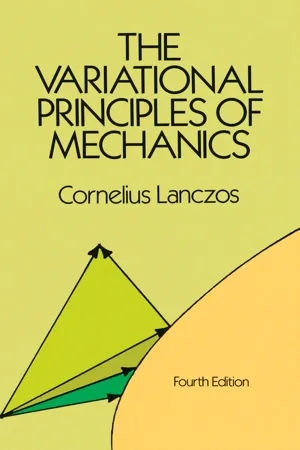
- 464 pages
- English
- ePUB (mobile friendly)
- Available on iOS & Android
The Variational Principles of Mechanics
About this book
Analytical mechanics is, of course, a topic of perennial interest and usefulness in physics and engineering, a discipline that boasts not only many practical applications, but much inherent mathematical beauty. Unlike many standard textbooks on advanced mechanics, however, this present text eschews a primarily technical and formalistic treatment in favor of a fundamental, historical, philosophical approach. As the author remarks, there is a tremendous treasure of philosophical meaning" behind the great theories of Euler and Lagrange, Hamilton, Jacobi, and other mathematical thinkers.
Well-written, authoritative, and scholarly, this classic treatise begins with an introduction to the variational principles of mechanics including the procedures of Euler, Lagrange, and Hamilton.
Ideal for a two-semester graduate course, the book includes a variety of problems, carefully chosen to familiarize the student with new concepts and to illuminate the general principles involved. Moreover, it offers excellent grounding for the student of mathematics, engineering, or physics who does not intend to specialize in mechanics, but wants a thorough grasp of the underlying principles.
The late Professor Lanczos (Dublin Institute of Advanced Studies) was a well-known physicist and educator who brought a superb pedagogical sense and profound grasp of the principles of mechanics to this work, now available for the first time in an inexpensive Dover paperback edition. His book will be welcomed by students, physicists, engineers, mathematicians, and anyone interested in a clear masterly exposition of this all-important discipline.
Frequently asked questions
- Essential is ideal for learners and professionals who enjoy exploring a wide range of subjects. Access the Essential Library with 800,000+ trusted titles and best-sellers across business, personal growth, and the humanities. Includes unlimited reading time and Standard Read Aloud voice.
- Complete: Perfect for advanced learners and researchers needing full, unrestricted access. Unlock 1.4M+ books across hundreds of subjects, including academic and specialized titles. The Complete Plan also includes advanced features like Premium Read Aloud and Research Assistant.
Please note we cannot support devices running on iOS 13 and Android 7 or earlier. Learn more about using the app.
Information
CHAPTER VIII
THE PARTIAL DIFFERENTIAL EQUATION OF HAMILTON-JACOBI
Table of contents
- Cover Page
- Title Page
- Copyright Page
- Dedication
- Preface
- Contents
- Introduction
- The Variational Principles of Mechanics
- I. The Basic Concepts of Analytical Mechanics
- II. The Calculus of Variations
- III. The Principle of Virtual Work
- IV. D’alembert’s Principle
- V. The Lagrangian Equations of Motion
- VI. The Canonical Equations of Motion
- VII. Canonical Transformations
- VIII. The Partial Differential Equation of Hamilton-Jacobi
- IX. Relativistic Mechanics
- X. Historical Survey
- XI. Mechanics of the Continua
- Appendix I
- Appendix II
- Bibliography
- Index